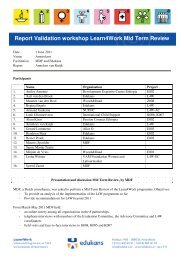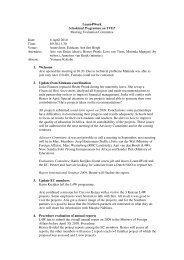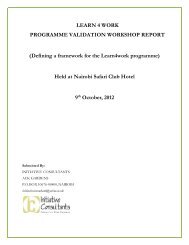Non â Formal TVET Mapping Survey Supported by Edukans ...
Non â Formal TVET Mapping Survey Supported by Edukans ...
Non â Formal TVET Mapping Survey Supported by Edukans ...
You also want an ePaper? Increase the reach of your titles
YUMPU automatically turns print PDFs into web optimized ePapers that Google loves.
<strong>Non</strong> – <strong>Formal</strong> <strong>TVET</strong> <strong>Mapping</strong> <strong>Survey</strong> The case of Amhara, Oromia and Addis Ababa<br />
level and very low average educational attainment and this characterize the Ethiopian<br />
work force of around 35 million people. No wonder if 26% of the work force is<br />
unemployed in urban areas may be a much larger figure in the rural areas.<br />
The way out from the problem of poverty is thought to be comprehensive capacity<br />
building and human capital formation. In this regard <strong>Non</strong> <strong>Formal</strong> and <strong>Formal</strong> <strong>TVET</strong> are<br />
expected to play key role in building the needed skilled, motivated and competent work<br />
force.<br />
1.2. Overview of NF-<strong>TVET</strong> in Ethiopia<br />
It has been decades since giving short-term non-formal technical and vocational training<br />
to different groups of youths and adults has started. Community Skill Training Centers<br />
(CSTC), prisons, farmers training centers, rural appropriate technologies, etc are known<br />
non-formal <strong>TVET</strong> training centers. The government, NGOs and the private sector have<br />
been running the different training programs. The purpose of all these organizations has<br />
been to build the capacity of the workforce and to alleviate poverty <strong>by</strong> providing skill<br />
trainings of the poor and improving their livelihood. Unfortunately the scale at which<br />
training has been given was so small that it has not made the substantive change on the<br />
majority of the poor<br />
In Ethiopia, some of the known trades given in NF<strong>TVET</strong> centers include woodwork,<br />
metal work, tailoring, embroidery, weaving, typing, computer training, driving, etc.<br />
These trades have been given in institutions like Community Skill Training Centers<br />
(CSTC), prisons and other government institutions. However experiences vary across<br />
regions in the country and in other countries regarding the types of trainings given and<br />
the modality under which it is given. It appears important to highlight the efforts made to<br />
establish CSTCs for giving training on indigenous crafts and modern trades.<br />
The historical background, achievements, strengths and weaknesses of CSTCs is well<br />
documented in the Internal Paper No33, June 2005 issued <strong>by</strong> IIZ/DVV. The following<br />
extract is made from this same document. Accordingly, the first Community Skills<br />
Training Centers were established in 1976 in various Woredas with the intention of<br />
initiating integrated rural development through a joint effort of all development sectors<br />
particularly those working at Woreda level. More specifically CSTCs were created to<br />
provide education and training to youths and adults who had completed their literacy<br />
education. The objectives were:<br />
Introduce and expand appropriate technology for the rural community,<br />
particularly the farmers;<br />
Improve the backward agriculture practice through farmers’ short term training;<br />
Train community members with different vocational skills training areas; and<br />
Establish a development resource center for the community at large.<br />
The many studies made on CSTCS indicate that they were not effective as expected.<br />
Some of the reasons documented are:<br />
Education Expertise Center Feb 2008 7







